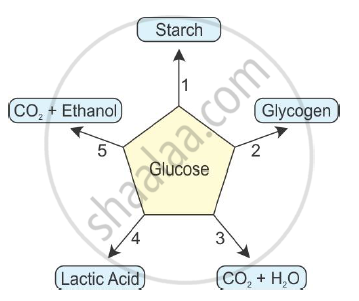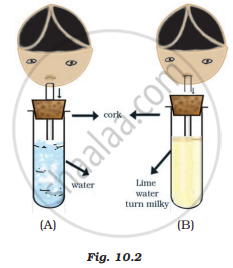Advertisements
Advertisements
Questions
What are the differences between aerobic and anaerobic respiration? Name some organisms that use the anaerobic mode of respiration.
What is the main difference between aerobic respiration and anaerobic respiration? Give one example of each.
Solution
| Aerobic respiration | Anaerobic respiration |
| It occurs in the presence of O2. | It occurs in the absence of O2. |
| It involves the exchange of gases between the organism and the outside environment. | Exchange of gases is absent. |
| It occurs in cytoplasm and mitochondria. | It occurs only in cytoplasm. |
| It always releases CO2 and H2O. | End products vary. |
| More energy is released. | Less energy is released. |
| For example, plants and animals (eukaryotes). | For example, yeast, bacteria. |
Some organisms that use the anaerobic mode of respiration are - yeast, bacteria, etc.
APPEARS IN
RELATED QUESTIONS
Given below are the end products of different reactions involving glucose.

Write the reaction number in front of the following:
(i) Anaerobic reaction =
(ii) Reaction in the human muscles =
(iii) Aerobic respiration =
(iv) Reaction in the plant cells =
(v) Reaction in the liver
Cellular respiration takes place in
(a) Lysosome
(b) Chlorophyll
(c) Mitochondria
(d) Ribosome
What advantage over an aquatic organism does a terrestrial organism have with regard to obtaining oxygen for respiration?
How are the lungs designed in human beings to maximize the area for exchange of gases?
What would happen if all the green plants disappear from the earth?
Which of the following is the correct statement regarding bile?
Name one substance which is produced in anaerobic respiration by an organism but not in aerobic respiration.
Name the pores in a leaf through which respiratory exchange of gases takes place.
Name the red pigment which carries oxygen in blood.
State whether the following statement is true or false:
Energy can be produced in cells without oxygen.
Describe the process of respiration in the following part of a plant:
Stem
What is meant by aquatic animals and terrestrial animals?
Explain how, it would benefit deep sea divers if humans also had gills.
Give the main points of difference between respiration in plants and respiration in animals.
When air is blown from mouth into a test-tube containing lime water, the lime water turns milky due to the presence of:
Which of the following statements are true about respiration?
(i) during inhalation, ribs move inward and diaphragm is raised.
(ii) the gaseous exchange takes place in the alveoli.
(iii) haemoglobin has greater affinity for carbon dioxide than oxygen.
(iv) alveoli increase surface area of the exchange of gases
Which of the following is known as the energy currency of the cells in biology?
Which of the following is most likely to have a much higher breathing rate?
What happens to the glucose which enters the nephron tubule alongwith the filtrate?
There is a pair of bean-shaped organs P in the human body towards the back, just above the waist. A waste product Q formed by the decomposition of unused proteins in the liver is brought into organ P through blood by an artery R. The numerous tiny filters S present in organ P clean the dirty blood by removing the waste product Q. The clean blood goes into circulation through a vein T. The waste substance Q, other waste salts, and excess water form a yellowish liquid U which goes from organ P into a bag-like structure V through two tubes W. This liquid is then thrown out of the body through a tube X.
(a) What is (i) organ P, and (ii) waste substance Q?
(b) Name (i) artery R, and (ii) vein T.
(c) What are tiny filters S known as?
(d) Name (i) liquid U (ii) structure V (iii) tubes W, and (iv) tube X.
In the lungs what substance is removed from the body?
Differentiate between
External respiration and Internal respiration
Answer the following in detail.
Explain the process of Cellular Respiration.
Choose the odd one out in the following groups of four items each:
Ethyl alcohol, Carbon dioxide, Starch, Oxygen
Name the body structure concerned with the given functional activity:
Prevents food from entering the trachea during swallowing.
Name the body structure concerned with the given functional activity:
Combines with the oxygen in the lungs.
Given below is an example of a certain structure and its special functional activity:
"Kidney and excretion".
Fill in the blanks on a similar pattern.
Pleura and _____________.
Given below is an example of certain structure and its special functional activity:
"Kidney and excretion".
Fill in the blanks on a similar pattern.
'C' shaped cartilage rings and ____________.
____________ is necessary for the respiration in plant.
What is common between extensive network of blood vessels around walls of alveoli and in glomerulus of nephron?
The Figure shown below represents an activity to prove the requirements for photosynthesis. During this activity, two healthy potted plants were kept in the dark for 72 hours. After 72 hours, KOH is kept in the watch glass in setup X and not in setup Y. Both these setups are air tight and have been kept in light for 6 hours. Then, Iodine Test is performed with one leaf from each of the two plants X and Y.

The function of KOH is to absorb ______.
Which of the following is an incorrect statement?
Which of the following equations is the summary of photosynthesis?
How does aerobic respiration differ from anaerobic respiration?
The exchange of gases in the leaves takes place with the help of __________.
Observe Figure 10.2 carefully and answer the following questions.

- Which process is being tested in the activity?
- What is the result of the activity? Give reasons.
List the similarities between aerobic and anaerobic respiration.
Visit a local doctor. Learn about the harmful effects of smoking. You can also collect material on this topic from other sources. You can seek help of your teacher or parents. Find out the percentage of people of your area who smoke. If you have a smoker in your family, confront him with the material that you have collected.
